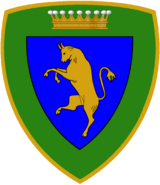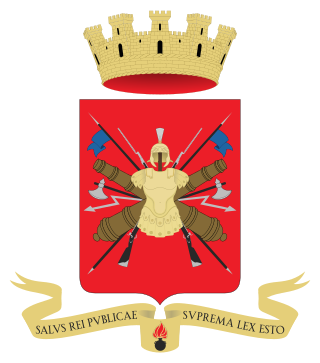
The Italian Army is the land force branch of the Italian Armed Forces. The army's history dates back to the Italian unification in the 1850s and 1860s. The army fought in colonial engagements in China, Libya, Northern Italy against the Austro-Hungarian Empire during World War I, Abyssinia before World War II and in World War II in Albania, Balkans, North Africa, the Soviet Union, and Italy itself. During the Cold War, the army prepared itself to defend against a Warsaw Pact invasion from the east. Since the end of the Cold War, the army has seen extensive peacekeeping service and combat in Afghanistan and Iraq. Its best-known combat vehicles are the Dardo infantry fighting vehicle, the Centauro tank destroyer and the Ariete tank and among its aircraft the Mangusta attack helicopter, recently deployed in UN missions. The headquarters of the Army General Staff are located in Rome opposite the Quirinal Palace, where the president of Italy resides. The army is an all-volunteer force of active-duty personnel.

The Alpini are the Italian Army's specialist mountain infantry. Part of the army's infantry corps, the speciality distinguished itself in combat during World War I and World War II. Currently the active Alpini units are organized in two operational brigades, which are subordinate to the Alpine Troops Headquarters. The Alpini's name comes from their inceptive association with the Alps, the mountain range that Italy shares with France, Switzerland, Austria, and Slovenia. An individual soldier of the Alpini is called Alpino.

The 4th Alpine Division "Cuneense" was a division of the Royal Italian Army during World War II, which specialized in mountain warfare. The headquarters of the division was in the city of Cuneo, and the majority of its Alpini soldiers were drafted from the surrounding Province of Cuneo - hence the division's name "Cuneense". The division participated in all Italian World War II campaigns with the exception of the North African Campaign. The division was annihilated during Operation Little Saturn by Soviet forces in January 1943.
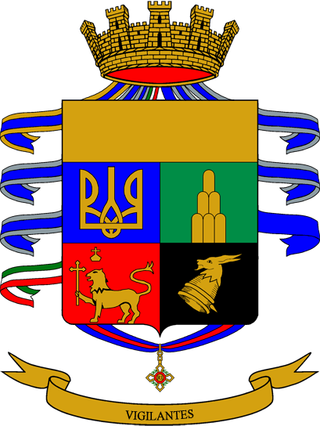
The 2nd Alpini Regiment is a regiment of the Italian Army's mountain infantry speciality, the Alpini, which distinguished itself in combat during World War I and World War II. The regiment was disbanded in 1943 due to losses on the Eastern Front, however one of its component battalions, the Alpini Battalion "Saluzzo", was reformed in November 1945 after the end of hostilities in Europe. The regiment itself was reformed in 1963 as a training unit, but during the 1975 army reform it was reduced to battalion. In 1992 the regiment was raised once again and today it consists of the Alpini Battalion "Saluzzo", is based in Cuneo and part of the Alpine Brigade "Taurinense".

The 1st Alpini Regiment is an active unit of the Italian Army's mountain infantry speciality, the Alpini, which distinguished itself in combat during World War I and World War II. The unit is based in Turin in Piedmont and operationally assigned to the Alpine Brigade "Taurinense".

The 3rd Alpini Regiment is a regiment of the Italian Army's mountain infantry speciality, the Alpini, which distinguished itself in combat during World War I and World War II. The regiment is based in Pinerolo and assigned to the Alpine Brigade "Taurinense".

The 4th Alpini Paratroopers Regiment is a ranger type special operations forces of the Italian Army, specializing in air assault, artillery observer, cold-weather warfare, direct action, forward air control, HUMINT, irregular warfare, ISTAR, long-range penetration, maneuver warfare, medical evacuation on mountain, military intelligence, mountain combat search and rescue, mountain rescue, mountain warfare, parachuting, special operation behind enemy lines, special reconnaissance, tactical emergency medical services, tracking targets on mountain, and urban warfare. The regiment is one of three regiments of the Army Special Forces Command. The regiment is a unit of the Italian Army's mountain infantry speciality, the Alpini, which distinguished itself in combat during World War I and World War II. The 4th Alpini Paratroopers Regiment is one of the most decorated units of the Italian Army, although its two Gold Medals of Military Valor were awarded to the regiment's currently inactive Alpini Battalion "Aosta", respectively the currently active Skiers Battalion "Monte Cervino".

The Alpine Brigade "Cadore" was a light Infantry brigade of the Italian Army, specializing in mountain warfare. Its core units were Alpini, the mountain infantry corps of the Italian Army, that distinguished itself in combat during World War I and World War II. The brigade was based in the Italian provinces of Belluno and Vicenza with its headquarters Belluno. The brigade was disbanded in 1997.

The Alpine Brigade "Julia" is a light infantry brigade of the Italian Army, specializing in mountain warfare. Its core units are Alpini, an infantry corps of the Italian Army, that distinguished itself during World War I and World War II. The brigade carries on the name and traditions of the 3rd Alpine Division "Julia". The division's and brigade's name allude to the Julian Alps in the Friuli region where the division's regiments recruited their troops, and where after World War II the brigade was based. Accordingly, the brigade's coat of arms is modeled after the Friuli region's coat of arms.

The 1st Field Artillery Regiment (Mountain) (Italian: 1° Reggimento Artiglieria Terrestre (montagna)) is a field artillery regiment of the Italian Army, specializing in mountain warfare. The regiment is based in Fossano in Piedmont and assigned to the Alpine Brigade "Taurinense". The regiment is the Italian Army's senior mountain artillery regiment as it was formed in 1887 by the Royal Italian Army. In World War I the regiment's groups and batteries served on the Italian front.

The 4th Mountain Artillery Regiment is an inactive mountain artillery regiment of the Italian Army, which was based in Susa in Piedmont. The regiment was formed in 1934 by the Royal Italian Army with mountain artillery groups that had served in World War I. The regiment was assigned to the 4th Alpine Division "Cuneense", with which it served during World War II in the invasion of France and the Greco-Italian War. In summer 1942 the division was transferred to the Soviet Union, where it was destroyed in winter 1942-43 during the Soviet Operation Little Saturn. The remnants of the division were repatriated in spring 1943 and invading German forces disbanded the division and its regiments after the announcement of the Armistice of Cassibile on 8 September 1943.

The 5th Alpine Division "Pusteria" was a division of the Royal Italian Army during World War II, which specialized in mountain warfare. The Alpini are a mountain infantry corps of the Italian Army, that distinguished itself in combat during World War I and World War II. The division was formed in 1935 and based in the Puster Valley, which gave the division its name.
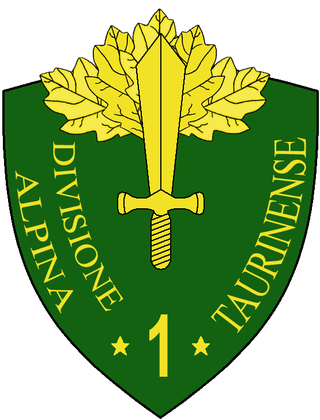
The 1st Alpine Division "Taurinense" was a division of the Royal Italian Army during World War II, which specialized in mountain warfare. The Alpini that formed the division are a highly decorated and elite mountain corps of the Italian Army consisting of both infantry and artillery units. Today, the traditions and name of the 1st Alpine Division "Taurinense" are carried on by the Alpine Brigade "Taurinense". The headquarters of the division was in the city of Turin and the majority of its soldiers were drafted from the surrounding Province of Turin — therefore the division was named "Taurinense" for the Roman name of the city of Turin Augusta Taurinorum.

The Comando Truppe Alpine or COMTA commands the Mountain Troops of the Italian Army, called Alpini and various support and training units. It is the successor to the 4º Corpo d'Armata Alpino of the Cold War. The Alpini are light Infantry units specializing in Mountain Combat. The subordinate units of the COMTA distinguished themselves during combat in World War I and World War II.
The article provides an overview of the entire chain of command and organization of the Italian Army after the reform of 1 October 2016 and includes all active units as of 1 July 2019. The Armed Forces of Italy are under the command of the Italian Supreme Defense Council, presided over by the President of the Italian Republic. The Italian Army is commanded by the Chief of the Army General Staff or "Capo di Stato Maggiore dell’Esercito" in Rome.
On March 1, 1984 the Italian Institute for Disarmament, Development and Peace (Istituto di ricerche per il disarmo, lo sviluppo e la pace in Rome published the entire Italian Army order of battle down to company level – this was justified by the radical party as one of its core demands was total disarmament of Europe, even though the data which was published was top secret. The Radical Party dissolved in 1989 and the IRDISP followed suit in 1990. But Radio Radicale has survived, and the OrBat can still be found today on the homepage of the radio.
The following is a hierarchical outline for the Italian Army at the end of the Cold War. It is intended to convey the connections and relationships between units and formations.
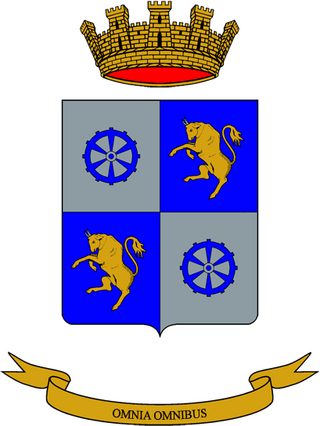
The Logistic Regiment "Taurinense" is a military logistics regiment of the Italian Army based in Rivoli in Piedmont. Originally a transport unit, the regiment is now the logistic unit of the Alpine Brigade "Taurinense" and shares with the brigade's infantry troops, the Alpini, the distinctive Cappello Alpino. The regimental anniversary falls, as for all units of the Transport and Materiel Corps, on 22 May, the anniversary of the Italian Army's first major automobile use to transport reinforcements to counter the Austro-Hungarian Offensive at Asiago in 1916.
With the 1975 reforms the Italian Army abolished the regimental level and replaced it with brigades made up of multiple arms. During the reform the army disbanded 48 regimental commands and reduced its force by 87 battalions. A further ten regimental commands were used to raise ten new brigade commands. Ten training centers, which for traditional reasons had carried the names of regiments, were also disbanded. The reduction in units also allowed to mechanize most of the remaining units in Northern Italy and Italy's defense strategy changed from a hold-at-all-costs territorial defense to one of mobile warfare.
